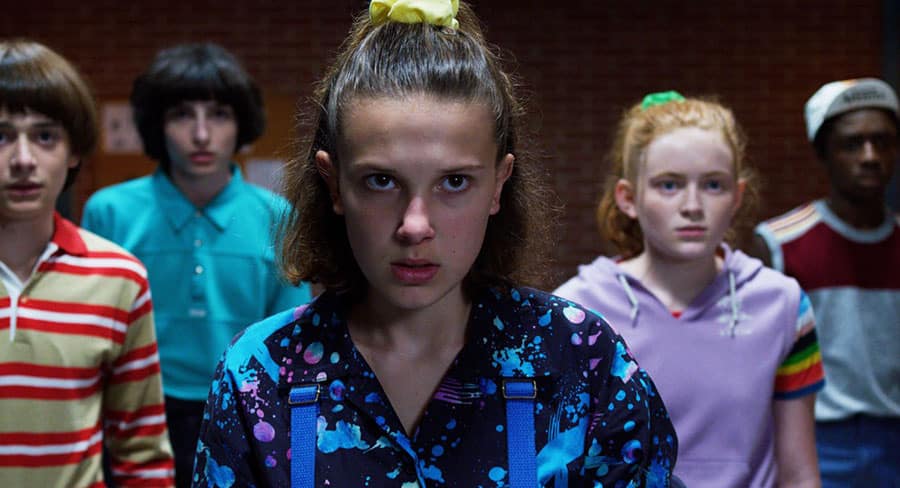Last month, Netflix’s share price tumbled after the news broke that the streaming giant had lost 200,000 subscribers globally. Shortly after the announcement was made, Netflix co-CEO Reed Hastings revealed his company’s prospective plans to launch an ad-supported tier.
Whilst there aren’t many details available as of yet about what an ad-supported subscription tier on Netflix would look like, Hastings said it’s expected to launch over the “next year or two”.
Mediaweek spoke to Andrew Gilbert, head of platform strategy for Australia & New Zealand at Yahoo, Stewart Gurney, chief strategy officer at Kaimera, and Paul Sinkinson, managing director Australia at Analytic Partners about what an ad-supported subscription tier would look like on the streaming giant, and what it would mean for advertisers.

Andrew Gilbert, Stewart Gurney, Paul Sinkinson
The Nuts and Bolts
Just how significant could an ad-supported Netflix subscription tier be for the industry? Sinkinson says it could be massive.
“With linear TV losing so many viewers, BVOD doesn’t look like it’s adding that much extra. Everybody says ‘oh, it’s adding incremental reach’, but it’s only adding five or six percentage points.
“We never know for sure what Netflix’s size is in Australia, but if the estimates of 6 million subscriptions and, 14 million viewers over a four week basis are real, that’s significant extra reach coming in. It’s got the potential to be massive – it’s a big question mark, though.”
For Gilbert and the team at Yahoo, supply – wherever it comes from – is very important. It’s also something that a new Netflix tier could supply in spades.
“When you start to get access to more and more premium supply, that just means better things for brands and marketers and their ability to achieve their objectives.
“If Netflix or any of the other subscriber platforms like Disney, etc, start to open that up, it just means more and more capabilities and more abilities for brands to be able to do that, and for us to be able to grow with those brands at the same time.”
There are some key factors that would need to be considered in launching an ad-supported subscription tier, and for Gilbert, it’s first and foremost about the consumer experience.
“It’s really important to think about what happens from a consumer point of view. There’s research out there from Deloitte that talks about how the number one reason why someone subscribes to a platform in the first place is low cost, but then the number one reason why they leave is high cost.
“If we’re talking about an ad-funded model where consumers still pay but they also get some ads coming through, the most important thing to think about is consumer experience.”

Bringing Ads to Netflix
For advertisers, the first question to ask would be about what sort of benefits a subscription tier on streaming platforms like Netflix could offer. Gilbert says that giving advertisers the ability to finally tap into the SVOD market is a major drawcard.
“From an advertising point of view, you have really strong and engaged consumers that have been sitting in these SVOD platforms for a long time that advertisers haven’t been able to reach.”
For now, however, Gilbert predicts that the reach might not be global.
“I don’t imagine that Netflix will open it up globally straightaway. They’ll no doubt test in different markets, and then they’ll start to scale it throughout wherever they need to.”
One of the challenges of creating an ad that would cut through on the platform comes from the fact that the demographics of Netflix consumers are so wide and varied.
“I would suggest that brands that can create advertising that is bespoke for that platform will probably resonate greater,” says Gurney. “Utilising people’s behaviours on the platform and any interesting or salient shows, I think that those are the big opportunities for brands.”
So which brands would be best suited to take up residence on a streaming platform like Netflix?
“If we start to talk about the different types of brands that may actually start to feed into it, it’ll be ones that want to go after these types of consumers that they haven’t been able to touch before,” says Gilbert. “It’ll be ones that want to personalise with potential data that Netflix has as well. Then it’ll be marketers that want to reach consumers that are instrumental to their free to air or linear TV buying that they do right now as well.”
As a multinational corporation itself, it would make sense that Netflix would draw the attention of major global advertisers. Hopefully, Gurney says, that isn’t the only sort of brand that runs on the platform.
“With a powerhouse like Netflix, you can automatically see the global brands and big global conglomerate deals being done, which might be at the detriment to some local brands, potentially, in certain categories – especially if they have things like category exclusivity as part of those deals. But I think it is a universally appealing proposition for lots of brands, depending on what their needs are.”

Bridgerton
Many of the streaming services don’t release exact viewer numbers – rather they release the occasional snapshot. While this fact presents another hurdle to jump when it comes to a potential ad-supported tier, Gurney says that it’s not an impossible one to clear.
“If I was sponsoring a show, or if I were sponsoring a segment, I’d be uncomfortable not knowing that level of data and what those reach numbers would be. However, like most BVOD, we tend to buy programmatically or buy on a CPM basis anyway, so we’re not actually buying programs. Typically we tend to buy the audience.
“I don’t think it’d be too much of a problem, but it would be if I was doing a big integration piece or something that is very bespoke around a show like Stranger Things – I’d want to know the exact numbers.”
As Sinkinson points out, however, it wouldn’t be the first time advertisers had gone in not knowing the exact numbers of eyeballs their products had attracted.
“I don’t think that we’ll need total users. If you think about it, when we’re measuring the impact of out of home, we don’t know exactly how many people walk past each billboard. We’re measuring radio and TV based on little samples. So there are ways around it.”
While the lack of exact viewer numbers may not pose too much of an issue, hurdles like password sharing may be harder to overcome. As Sinkinson says, it’s a problem that is incredibly widespread.
“There’s the hype that we get sold on of ‘right person, right time’ when it comes to serving people an ad. Then there’s the reality of it, which is that if somebody in their 40s has the account, we know from password sharing that you’re probably hitting a family rather than a specific person.
“What is the amount of meaningful targeting that you’ll really be able to do? Who knows. Netflix themselves don’t know who their users are because of this password sharing problem.”
Gilbert says this issue may bite especially hard when it comes to personalising ads.
“If Netflix is going to come to market with this and they’re going to talk about targeting, they may choose to keep their data to themselves and only have a relationship with the advertiser. We know that they are really quite restrictive in terms of sharing that data with brands.
“If they’re going to share it, it’s going to be a premium agreement with advertisers a lot of the time, and then potentially as a supplement. They may start to share it with the platforms they can target as well.”

Stranger Things
Looking Ahead
Whilst it’s always difficult to peer into the crystal ball, Gurney says that the impact of a streaming service subscription tier could be felt in the industry all the way down to the local level.
“I can see something like Netflix coming in and really eating a lot of the BVOD players’ pie, so that could be quite a big threat to how they operate.
“Coca-Cola has done stuff with Stranger Things globally. I really hope that we’re not going to see global companies coming in and taking over and not giving opportunities for local brands to be able to build their own connections with audiences using the Netflix platform.”
While an ad-supported tier on Netflix may eat into the BVOD pie, Sinkinson says that linear TV may also see the impacts of this decision.
“It’s more likely that the TV networks are going to be impacted by it. But having said that, I think it’s Nirvana for advertisers. This would put us back to the point where we can say that linear TV, streaming TV, and some YouTube or social can get you back to that big reach that you need.”
The changes of the future may not be so far away, and Gilbert says that you may not need that crystal ball after all to see what lies ahead for the industry.
“Netflix isn’t the first to do it, you’ve got providers in market like Tubi that already do this as a free supported model. It’s not going to be something that’s going to affect the industry going forward, it’s a change that’s already started to happen.”
